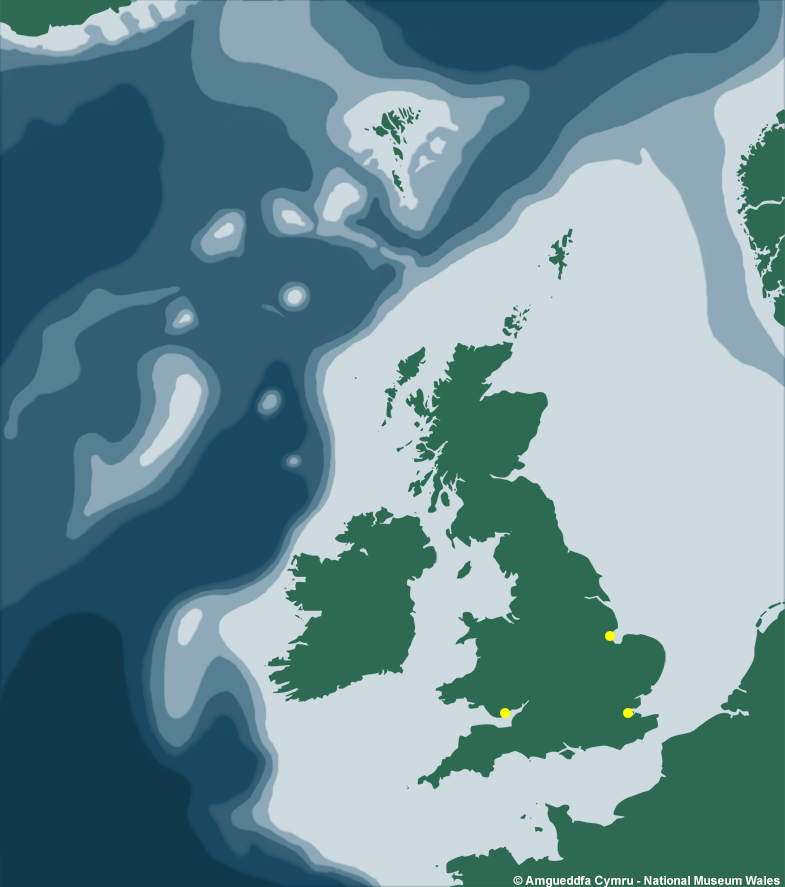Mytilopsis leucophaeta (Conrad, 1831)
Dreissenoidea : Dreissenidae | Non-native |
| Tebble name: | n/a |
| Smith & Heppell name: | n/a |
To size: Up to 4cm. Shell Structure: Thin but not fragile. Equivalve: Slightly inequivalve (RV slightly larger). Equilateral: Strongly inequilateral. Tumidity: Tumid. Outline: Mytiliform, narrow wedge-shaped.
Sculpture: Commarginal lines and growth stops. Margin: Inner margin smooth. Ligament: External, sunken. Hinge: Septum (shelf) with a triangular tooth arising from the inner dorsal edge. Pallial Musculature: Posterior adductor and pedal retractor scars coalesced as a long, crescent shape on posterior dorsal area. Pallial line slightly concave below the adductor scar. Periostracum: Thick with dense erect concentric laminae. Colour: Brown periostracum, white shell, tinged with purple.
Distribution & Ecology
Native to the Gulf of Mexico it has spread in ballast water North to the Hudson River in New York state and south to Brazil. Distributed in Europe from Normandy to Denmark, Mediterranean, Black Sea and Caspian Sea.
Known from a few scattered locations in the UK: Roath Dock, Cardiff; Cliffe Fort Lagoon, Kent and Hubbert’s Bridge, Boston, Lincolnshire.
Depth Range
Intertidal

Additional Information & Related Species
Key Features & Similar Species
Related Species
Dreissenoidea : Dreissenidae
References
Listed are literature citing Mytilopsis leucophaeta (Conrad, 1831). Reference containing the species Type Description is highlighted.
|
Bamber R.N. & Taylor J.D. 2002. The brackish water mussel Mytilopsis leucophaeta (Conrad, 1831) (Bivalvia: Dreissenidae) in the river Thames. Journal of Conchology. 37 (4): 403-404. |
|
Conrad T A 1831. Description of fifteen new species of Recent, and three of fossil shells, chiefly from the coast of the United States. Journal of the Academy of Natural Sciences of Philadelphia. 6: 256-268, pl 11. |
|
Oliver P.G., Holmes A.M. & Mettam C. 1998. A species new to the British fauna. Journal of Conchology. 36 (2): 13-18. |
|
Willing M.J. 2015. Two invasive bivalves, Rangia cuneata (GB Sowerby I, 1831) and Mytilopsis leucophaeta (Conrad, 1831), living in freshwater in Lincolnshire, Eastern England.. Journal of Conchology. 42 (2): 189-192. |
Resources
- Conchological Society
of Great Britain & Ireland
Provides resources for understanding, identifying, recording, and conserving molluscs - CLEMAM
Check List of European Marine Mollusca - MarLIN
The Marine Life Information Network for Britain and Ireland (MarLIN) provides information for marine environmental management, protection and education. It is a centre of excellence in spatially based and time-series marine biological information and supports good stewardship in the marine environment. - NBN Gateway
National Biodiversity Network's Gateway. Use it to explore UK biodiversity data, as contributed by participating data providers. - BivAToL
- MarBEF
- Malacological Society
- Unitas Malacologica
- Census of Marine Life
- MarBEF
MarBEF, a network of excellence funded by the European Union and consisting of 94 European marine institutes, is a platform to integrate and disseminate knowledge and expertise on marine biodiversity, with links to researchers, industry, stakeholders and the general public.











